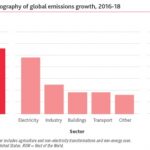Article 6 of the Paris Agreement creates the framework for mechanisms that will allow nations and sub-national actors to trade emissions. Executed correctly, it must raise ambitions and reduce total emissions. It must also ensure there is transparent and accurate accounting for emissions, with no double-counting. It made little progress at December’s COP25. This was partly due to some countries “insisting on accounting loopholes”, writes Isabella … [Read more...]
Don’t wait for international agreements. Sector-wide action can accelerate the Transition
December’s COP25 in Madrid showed how difficult it is proving to get agreement between nations on how to ramp up the deep decarbonisation the world needs. David Victor at the University of California, San Diego, writing for Rocky Mountain Institute, accepts that international consensus is never going to be easy. Instead, he recommends that individual sectors take control of their destiny. His co-authored report “Accelerating The Low Carbon … [Read more...]
COP25: the “easy wins” are coming to an end. What now?
Lola Vallejo at IDDRI says the impressive wins we’ve seen so far in clean electrification are merely the easy “low hanging fruit”. Other big sectors like transport, buildings and industry have barely started to transition. As COP 25 convenes in Madrid this week, the world will want to know what promises will be made - via each country’s self-imposed enhanced Nationally Determined Contributions (NDCs) - to meet the Paris goals, because the current … [Read more...]
NDC reporting: making the Paris Agreement Transparency Framework work
For the system of Nationally Determined Contributions (NDCs) to be effective, every country’s reporting processes need to be appropriate to their economic level, honest and accurate. That means the Paris Agreement’s Transparency Framework, including the Common Reporting Tables (CRT) for greenhouse gas inventories, and Common Tabular Formats (CTF) to track progress on their NDCs, needs to be finalised and agreed upon, and fast, says the IDDRI’s … [Read more...]





